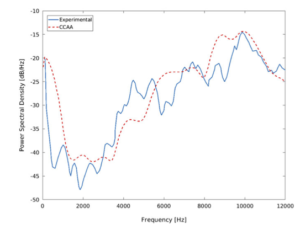From a physics point of view, sibilant fricative sound production is generally described as noise produced due to the interaction of a turbulent jet, issued from a constriction between the tongue and the hard palate – i.e. the sibilant groove – somewhere in the vocal tract, with a downstream wall or obstacle as illustrated in the figure below. Consequently, acoustic features of sibilant noise are influenced by both flow and geometrical parameters and frequencies up to 15 kHz are of interest. With this in mind, three different aspects of sibilant fricative sound production are investigated combing modeling (A), experiments (B) and numerical simulation (C).

illustration of vocal tract configuration during sibilant fricative /s/ production.
(A) Modeling the influence of a complex cross-section shape on the acoustic field
Analytical solutions of the two-dimensional Helmholtz equation are limited to particular domain shapes, so that in general numerical methods are used when an arbitrary domain is considered. In this paper, a quasi-analytical solution is proposed, suitable to be applied to an arbitrary domain shape. Concretely, the Helmholtz equation is transformed to ac- count for a conformal map between the shape of the physical domain and the unit disk as canonical domain. This way, the transformed Helmholtz equation is solved exploiting well-known analytical solutions for a circular domain and the solution in the physical domain is obtained by applying the conformal map. The quasi-analytical approach is compared to analytical solutions for the case of a circular, elliptic and squared domain. This work encourages further analytical model efforts and is detailed in [1].
(B) Experimental evidence of the influence of the lip horn on the directivity
Influence of the lip horn on the acoustic pressure distribution of the sibilant /s/ was experimentally studied using a vocal tract replica to which a rectangular baffle was added to represent a human face. The sound was generated by a sweep sound source (Frequency: 2–15 kHz) positioned at the inlet of the pharynx or by air flowing through the replica. The sound generated by the sweep source was measured along two semi-circles of radius 4 cm every 2 degrees (near-field) and radius 48 cm every 15 degrees (far-field), where as the sound generated by the flow was measured along semi-circles of radius 10 cm every 2 degrees. From the normalized pressure distributions, it was observed that the lip horn enhances the pressure amplitude up to 15 dB at the center of the lips in both transverse and sagittal plane in the frequency range above 5 kHz. The pressure distribution patterns (e.g. Figure below) measured with the acoustic source were similar to those measured with the flow supply. This indicates that the pressure pattern of sibilant /s/ is affected by the vocal tract geometry rather than by the source characteristics. This work encourages further experimental as well as modeling work and is reported in [2].

Effects of lips on directivity measurement along the sagittal plane at 6.1 kHz.
(C) Aero-acoustic simulation of sibilant fricative
A sibilant fricative /s/ is generated when the turbulent jet in the narrow channel between the tongue blade and the hard palate is deflected downwards through the space between the upper and lower incisors and then impinges the space between the lower incisors and the lower lip. The flow eddies in that region become a source of direct aerodynamic sound, which is also diffracted by the speech articulators and radiated outwards. The numerical simulation of these phenomena is complex. The spectrum of an /s/ typically peaks between 4 and 10 kHz, which implies that very fine computational meshes are needed to cap- ture the eddies producing such high frequencies. In this work, a large-scale computation of the aeroacoustics of /s/ has been performed for a realistic vocal tract geometry, resorting to two different acoustic analogies. A stabilized finite element method that acts as a large eddy simulation model has been adopted to solve the flow dynamics. Also, a numerical strategy has been implemented that allows the determination, in a single computational run, of the separate contri- bution of the sound diffracted by the upper incisors from the overall radiated sound. Results (Figure below) are presented for points located close to the lip opening showing the relative influence of the upper teeth depending on frequency. This work encourages further research towards simulation strategies and is reported in [3].

Simulated (CCAA) and pronounced (experimental) power spectral density of /s/.
References :
[1] Van Hirtum A., 2017. Quasi-analytical solution of two-dimensional Helmholtz equation. Applied Mathematical Modelling, 47:96-102.
[2] Yoshinaga T., Van Hirtum A., Nozaki K., Wada S., 2018. Influence of the lip horn on acoustic pressure distribution pattern of sibilant /s/. Acta Acustica, 104:145-152.
[3] Pont A., Guasch O., Baiges J., Codina R. Van Hirtum A., 2019. Computational aeroacoustics to identify sound sources in the generation of sibilant /s/. Int. J. for Numerical Methods in Biomedical Engineering, 35:e3153.





